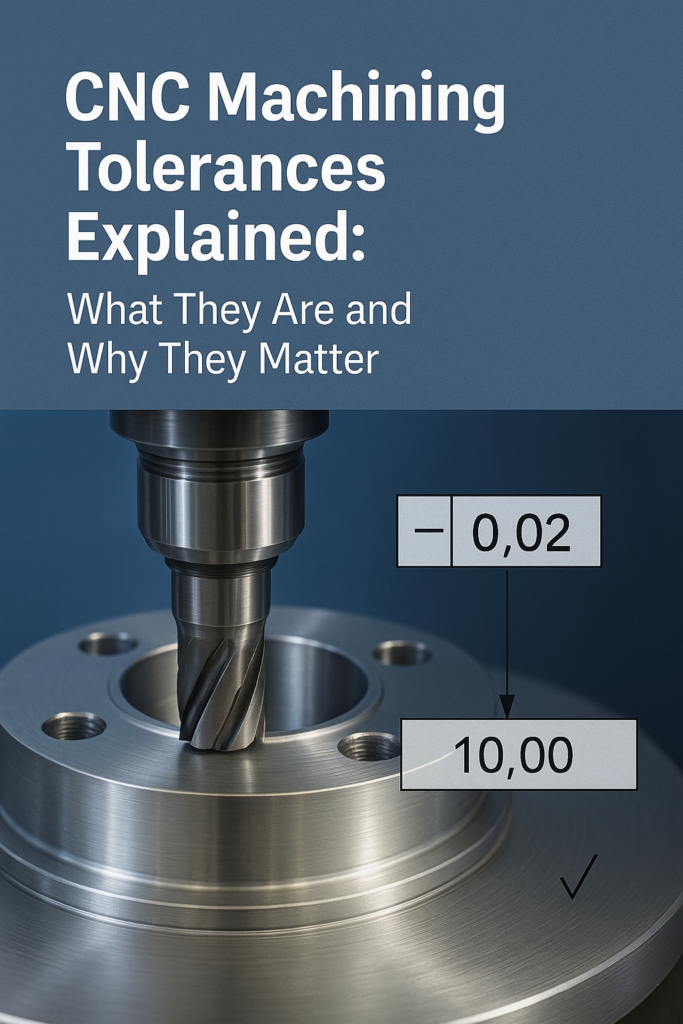When it comes to precision manufacturing, few terms are as important—or as misunderstood—as tolerances. Whether you’re creating a prototype or mass-producing parts, understanding CNC machining tolerances is essential to ensuring your parts fit, function, and last as intended.
In this article, we break down what tolerances mean in CNC machining, the different tolerance grades, and how they affect quality, cost, and lead time.
What Are CNC Machining Tolerances?
Why Do Tolerances Matter?
Poor tolerance control may result in:
Loose fits or excessive friction
Assembly failure
Vibration, wear, or leaks
Increased rejection rates and wasted material
On the other hand, tight tolerances require more time, skill, and precision to achieve, which raises costs. That’s why it’s important to balance functionality with manufacturability.
Common CNC Tolerance Standards
While tolerances can be customized for any part, the industry typically uses the following standard tolerances unless otherwise specified:
| Type | Standard Value | Application |
|---|---|---|
| General Tolerance | ±0.1 mm to ±0.2 mm | Non-critical features, standard parts |
| Fine Tolerance | ±0.01 mm to ±0.05 mm | Precision mechanical components |
| Tight Tolerance | ±0.005 mm or tighter | Aerospace, medical, and high-performance parts |
📌 Note: Tolerances also depend on the material and the type of CNC machine used (e.g., 3-axis vs. 5-axis).
Types of Tolerances in CNC Machining
Understanding the different forms of tolerances can help you design better parts and communicate requirements clearly with your CNC supplier.
1. Linear Tolerances
Controls allowable variation in length, width, or height.
Example: A block with dimensions 100.00 mm ± 0.05 mm.
2. Geometric Tolerances (GD&T)
Specifies form, orientation, location, and runout of features.
Common symbols: flatness, concentricity, perpendicularity.
3. Surface Finish Tolerances
Indicates how smooth a machined surface should be.
Measured in Ra (roughness average), e.g., 1.6 μm Ra.
4. Hole and Shaft Fits (Clearance, Transition, Interference)
Determines how tight or loose mating parts should fit.
Based on international systems like ISO or ANSI fits.
How to Choose the Right Tolerance?
Over-specifying tolerances can lead to higher costs, longer lead times, and higher rejection rates. Under-specifying can result in poor performance.
Best Practices:
✅ Apply tight tolerances only to critical features
✅ Use general tolerances for non-functional surfaces
✅ Communicate with your machining partner early in the design stage
✅ Use GD&T to describe complex dimensional relationships
CNC Machining Tolerances: Cost vs. Precision
Achieving tighter tolerances involves:
Slower machining speeds
Higher-grade tools and machines
More frequent inspections and adjustments
Increased material waste
As a rule of thumb:
The tighter the tolerance, the more expensive the part.
Why Tolerance Management Matters in Production
If you’re transitioning from prototype to production, understanding and managing tolerances becomes even more important. Consistency, scalability, and quality control depend on a well-defined tolerance strategy.
At T-one, we help clients optimize their designs for both function and manufacturability. Our engineers review each project’s tolerance requirements to strike the right balance between precision and practicality.
Summary: Tolerances Are the Language of Precision
| Situation | Recommended Tolerance |
|---|---|
| Prototype or visual model | ±0.2 mm |
| General-purpose metal part | ±0.1 mm |
| Functional or moving component | ±0.05 mm or better |
| Aerospace, defense, or medical | ±0.01 mm or tighter |
Understanding CNC machining tolerances isn’t just for engineers—it’s for anyone who wants their parts made right the first time.
Need High-Precision CNC Parts? Let’s Talk.
Our team at T-one specializes in tight-tolerance CNC machining for clients in automotive, aerospace, robotics, and beyond. Whether you’re designing for high-speed performance or long-term durability, we’ll deliver parts that meet your exact specs.
📩 Get a Free Quotation | 💬 Contact Us to Review Your Drawing
